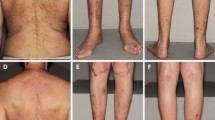Summary
Background: Hereditary benign intraepithelial dyskeratosis (HBID) is a rare autosomal dominant disorder with incomplete penetrance. It is characterized by bilateral limbal conjunctival plaques combined with similar changes in the oral mucosa.
Patient: An 11-year-old African-American patient presented with bilateral chronic conjunctivitis, nasal and temporal limbal conjunctival plaques, and plaques of the oral mucosa, all of which resisted therapy. The onset of the symptoms was in early childhood. Conjunctival smears, allergy tests, blood samples and the internal examination were inconclusive. Histologically, the ocular lesions showed acanthosis, parakeratosis, hyperkeratosis and dyskeratosis. An infiltrate of chronic inflammatory cells was present beneath the intact epithelial basement membrane.
Conclusions: The clinical and histological findings are characteristic of HBID. Symptoms usually start in early childhood and show a waxing and waning course. HBID was first seen among Haliwa Indians in North Carolina. In the meantime HBID has been described in other parts of the US and also in Europe. As these patients were not related to any of the Haliwa Indians, they are considered new mutations. Malignant changes of the conjunctival or oral lesions have not been reported.
Zusammenfassung
Hintergrund: Die hereditäre benigne intraepitheliale Dyskeratose (HBID) ist eine seltene autosomal-dominante Erkrankung mit unvollständiger Penetranz. Charakteristisch sind beidseitige paralimbäre konjunktivale keratotische Plaques in Kombination mit gleichartigen Veränderungen der Mundschleimhaut.
Kasuistik: Bei einem 11 jährigen afro-amerikanischen Jungen bestanden seit frühester Kindheit eine beidseitige chronische therapierefraktäre Konjunktivitis mit nasalen und temporalen paralimbären keratotischen Plaques und keratotische Mundschleimhautveränderungen. Abstrichdiagnostik, Allergietestung, Blutuntersuchungen und der internistische Befund waren unauffällig. Histologisch zeigen die okulären Veränderungen ein akanthotisches, parakeratotisches und hyperkeratotisches Epithel mit multiplen Dyskeratosen. Die epitheliale Basalmembran ist intakt, die Substantia propria ist chronisch entzündlich infiltriert.
Schlußfolgerung: Klinische und histologische Befunde des vorgestellten Patienten sind charakteristisch für HBID. Die Symptomatik beginnt in der Kindheit und im Laufe des Lebens kommt es typischerweise zu Reaktivierungen und Remissionen. HBID wurde ursprünglich bei den Haliwa-Indianern in North Carolina, USA, beobachtet. Inzwischen sind Patienten mit HBID auch in anderen Teilen der USA und in Europa bekannt geworden. Wegen des fehlenden verwandtschaftlichen Bezuges zu den Haliwa-Indianern wurden diese Fälle als Neumutationen gedeutet. Maligne Entartungen der konjunktivalen oder oralen Läsionen sind nicht beschrieben.
Similar content being viewed by others
Author information
Authors and Affiliations
Rights and permissions
About this article
Cite this article
Dithmar, S., Stulting, R. & Grossniklaus, H. Hereditary benign intraepithelial dyskeratosis. Ophthalmologe 95, 684–686 (1998). https://doi.org/10.1007/s003470050335
Published:
Issue Date:
DOI: https://doi.org/10.1007/s003470050335




